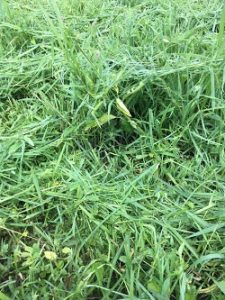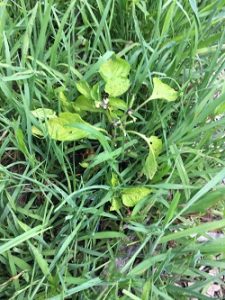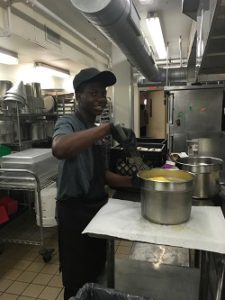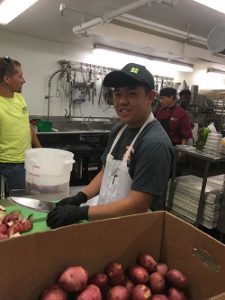This week’s blog entry is from a guest writer. If you are interested in being a guest blogger, contact [email protected].
By: Ann Swanson, Hendrick House Food Service
♪ ♫ Let’s talk about weeds bay- beee, let’s talk about you and me, let’s talk about all the bad things and the good things that involve wee – ding- ing, let’s talk about weeds! ♪ ♫
 Can you find the pepper plant?
Can you find the pepper plant?
Well I have to say there is more bad than good when talking about weed management for farms. It is definitely one of the toughest tasks that I face each year. Weed management is something every farm must evaluate and decide while planning their farm in the off season. Why weed management? Weeds can out compete your plants for sunlight and soil nutrients. They can also help spread disease and pests to healthy plants.
There are many different styles of weed control. Some of these styles are cultural, mechanical, and chemical. It is our preference not to use herbicide in order to be good stewards to the land. Everyone has their own method and this post is not going to debate organic vs. nonorganic. Since we are not using herbicide, it makes weed control challenging and vital to our operation. Most of our methods are mechanical, meaning we use a mower to cut down our weeds/ cover crop between path spaces and a weed eater to get the smaller areas. We also rely heavily on plasticulture, meaning we make raised beds covered in plastic and poke holes in the top to plant. This is a bit controversial due to the waste it creates. The plastic is non-reusable from year to year and sometimes, it is hard to get all of the pieces removed from the ground at the end of the growing season.
 In years past we have had almost our entire farm in plastic. Labor is our biggest expense and it reduces the time we spend on weeding immensely. However, this year I wanted to experiment reducing the use of plastic and using other tools I learned from conferences in the off season. I mentioned in a previous post that we purchased some new equipment to assist us with this experiment. Our goal is to plant into stale seed beds that we prepped with shallow tillage and a flame weeder. Stale seed beds mean we have killed the weed seeds just before we plant into the bed so the plants have a head start. We are still practicing with the seeder, trying to get our plantings close enough to where the plants will shade out the weed seeds. Even with the bed prep, the weeds have been growing at an alarming rate due to the rainy months of May/ June.
In years past we have had almost our entire farm in plastic. Labor is our biggest expense and it reduces the time we spend on weeding immensely. However, this year I wanted to experiment reducing the use of plastic and using other tools I learned from conferences in the off season. I mentioned in a previous post that we purchased some new equipment to assist us with this experiment. Our goal is to plant into stale seed beds that we prepped with shallow tillage and a flame weeder. Stale seed beds mean we have killed the weed seeds just before we plant into the bed so the plants have a head start. We are still practicing with the seeder, trying to get our plantings close enough to where the plants will shade out the weed seeds. Even with the bed prep, the weeds have been growing at an alarming rate due to the rainy months of May/ June.
Cover cropping and proper crop rotation also helps with weed control. We are not able to do either of those well with the small amount of land we are on but I am very excited to be able to apply these methods to our new farm we are moving to this fall.
 Switching gears I would like to mention/ gush about our high school student interns this year. Hendrick House is participating in SYEP and CARE4U programs, helping to facilitate real on job training for students. We were lucky enough to be paired with two outstanding young adults named Travis Makabu and Tony Bien, from Centennial High School and Urbana High School respectively. Hendrick House is a unique business for many reasons but one of those reasons is that we can offer a true farm to table experience. Travis and Tony have been splitting their time on the farm and in the kitchen. They have seen the produce as it is growing in the field. They have harvested it. They have processed it down into meals at Hendrick House. This is a fantastic opportunity for us to really push local food education while also providing life skills for the students. Travis and Tony have exceeded my expectations with their hard work, great attitudes and willingness to learn. Bravo to them for stepping out of their comfort zones and really excelling!
Switching gears I would like to mention/ gush about our high school student interns this year. Hendrick House is participating in SYEP and CARE4U programs, helping to facilitate real on job training for students. We were lucky enough to be paired with two outstanding young adults named Travis Makabu and Tony Bien, from Centennial High School and Urbana High School respectively. Hendrick House is a unique business for many reasons but one of those reasons is that we can offer a true farm to table experience. Travis and Tony have been splitting their time on the farm and in the kitchen. They have seen the produce as it is growing in the field. They have harvested it. They have processed it down into meals at Hendrick House. This is a fantastic opportunity for us to really push local food education while also providing life skills for the students. Travis and Tony have exceeded my expectations with their hard work, great attitudes and willingness to learn. Bravo to them for stepping out of their comfort zones and really excelling!



